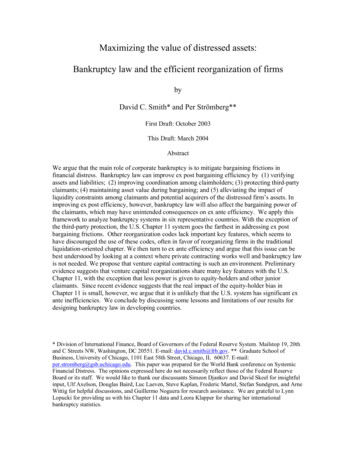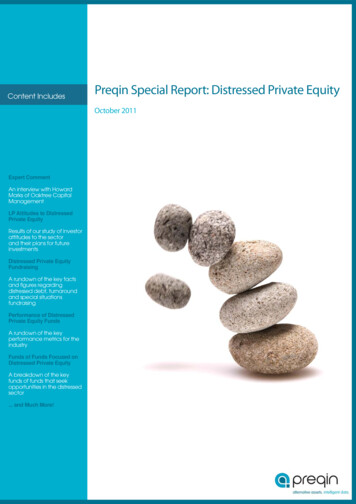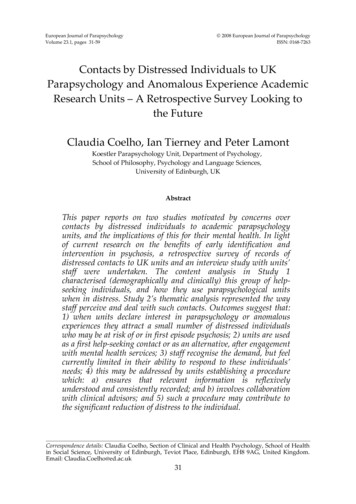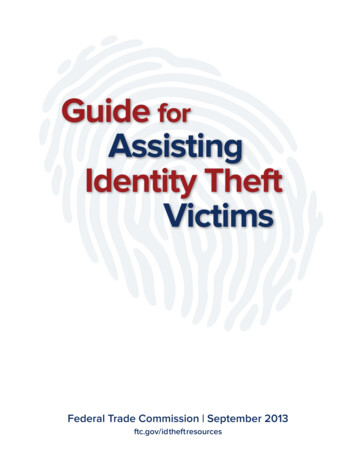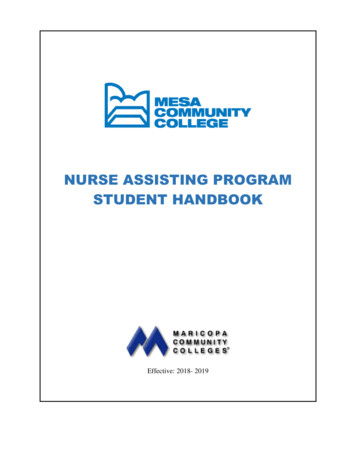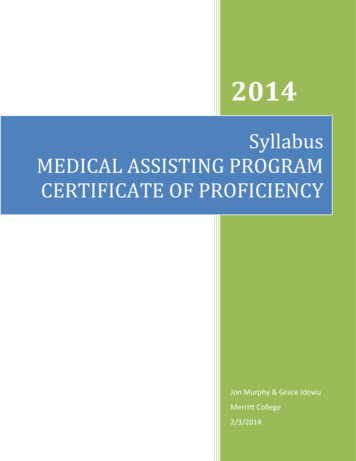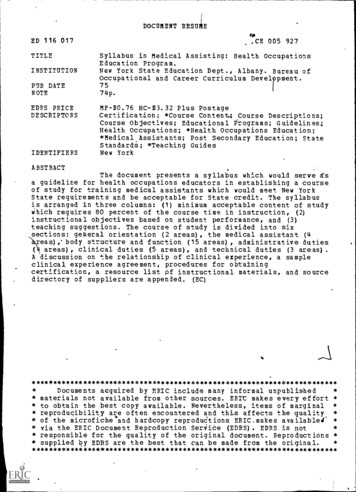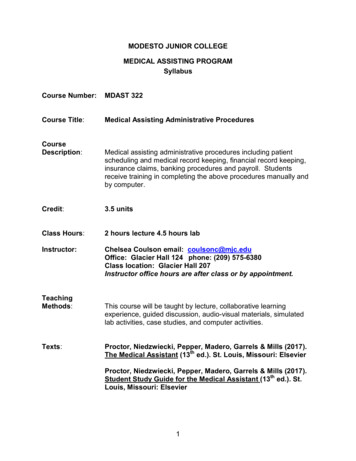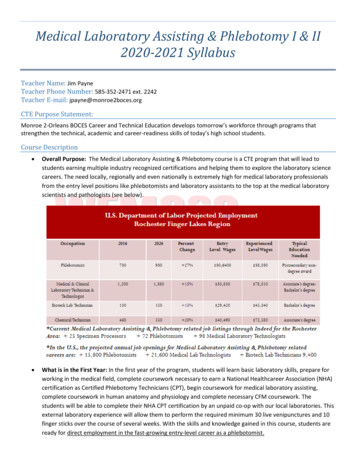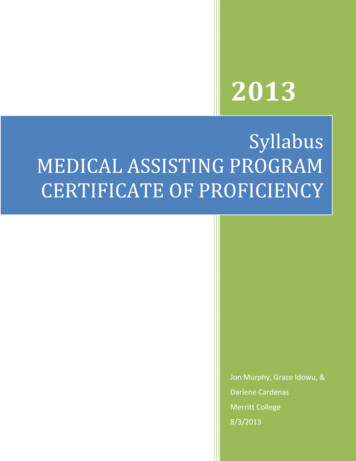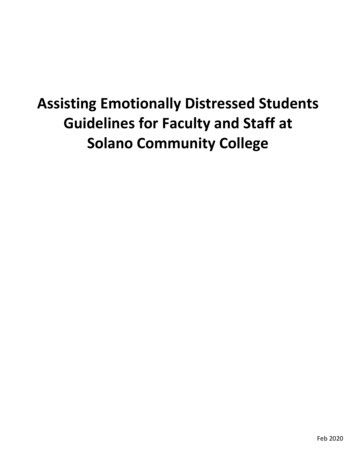
Transcription
Assisting Emotionally Distressed StudentsGuidelines for Faculty and Staff atSolano Community CollegeFeb 2020
SOLANO COMMUNITY COLLEGE Procedure forImmediate Student EmergencyEmotionally Distressed StudentActive or PlannedViolent or ThreateningBehavior toward Self orOthersPerceived ConcernSuicidalHomicidalPhysically AbusiveSexually AbusiveCALL 911Cell PhoneUsers Call:707-421-7090Disruptive Campus BehaviorCALL 911Cell Phone UsersCall:707-421-7090Expressing suicidal thoughts, without a planExcessive demand for assurance or supportExcessive nervous or anxious behavior,sad, crying, or depressedProvide student with Wellness CounselingReferral or Community Resources Sheet(see attachments at end of packet)ORContact and/or escort student to CounselingDept.Please call Staff Hotline before coming over:707-864-7000 xt. 4577 (hours: M-Th 8:30–6pm/F 8:30-3)CommunityResourceClassroom InstructorConsultationwith Early Alert Program Referral(depending on situation)Option:*Remove student from that classand the next class.Written Incident ReportDirected to: Division/DepartmentChair,Instructional Dean, and VPStudent ServicesCounselor ReferralTo appropriate:CampusResourceDisruptive Classroom BehaviorIf needed student maybe referred to Early AlertProgram or providedCommunity ResourcesSheet**VP of StudentServices or Designeefor DisciplinaryAction*See State of CA Education Code definition for Faulty removal of students from class for “good cause”.**Disciplinary action may occur through official warning (documentation), written probationary contract, expulsion or suspension
Role of Faculty/StaffFaculty/Staff are in an excellent position to observe and recognize behaviors and emotions that are troubling students.A student’s behavior, especially if it is changed from previous interactions, may be a subtle or unconscious “cry for help.”The ability to recognize the signs of emotional distress and a willingness to listen and express those concerns to studentsare important first steps in assisting students in distress. You are only expected to reach out to a student in troubleand direct her/him to a more appropriate referral, be it to a Wellness Counselor, Counseling Services, Early AlertProgram, external resources or the Sheriff’s Office.Crisis InterventionCrises are personal difficulties or situations that immobilize and prevent people from using their customary methods ofproblem solving. If the threat is imminent, you should call 707-421-7090.Contact the Sherriff’s office (cell phone: 707-580-6526) or call 707-421-7090 for the following:Direct threat to others - physical assault or witness to an assault or accidentDirect threat to self - suicidal/ homicidal thoughts and impulsesPhysical abuseSexual assaultReferral to Wellness CounselingWellness Counseling (mental health therapy consisting of 5-8 sessions) will be provided on Monday – Thursday at theFairfield Campus by JFK University PsyD or Master’s degree recent grads or current students. They will be supervisedby JFK faculty as they accrue hours toward licensure.What Can Wellness Counselors Help Students With?Test AnxietyManaging work, familyand schoolresponsibilitiesAcclimating to College life(e.g. organizational skills,course loadmanagement)Cultural andFamilial IssuesRelationship IssuesLife transitionsConflicts and/orexploration of IdentityIssues relating toLGBTQ stance use(personal or familial)Trauma/PTSDCrisis, Self/harm,suicide (not essionAcademic UnderachievementClassroom behavioralissuesActing out behaviorsSocial interactionissuesFamily crisisLow self-esteemDivorce/separationAnd More!Referral Process- Direct the student to come (or phone or email) to Counseling Services (students are encouraged to self-refer)- Students will fill in a referral form which will be given to the JFK Wellness Counselor (also included at end of packet)- JFK Wellness Counselor will contact the student directly to assess needed services and set up appointments**Please note, wellness counseling is NOT for immediate crisis situations. If you feel the student is an immediatedanger to self or others, please call the Sherriff’s office. **
Referral to Counseling ServicesIf a student needs immediate attention, please call the staff hot-line to let us know there is a student in need. Ifyou can walk the student over to Counseling Services, please do so. If the student cannot walk to CounselingServices, request Counseling Services staff to meet the student elsewhere.Location: Building 400, Counseling Department, 1st floor, Main CampusMonday–Thursday: 8:30 am– 6:00 pm; Friday 8:30 am – 3:00 pm (Hours subject to change when classes not in sessionand during summer)Staff Hotline: 707-864-7000, ext. 4577 or the front desk 707-864-7101 will assess the situation for appropriateassistance.Referral to Early Alert ProgramThe Early Alert program is under the Dean of Academic Support Services. Focus is on Level 1 Concerns(Attendance/Lateness, Late/Missing Assignments, Poor exam/quiz scores, lack of classroom engagement/motivation, orpoor study skills/time management/preparation).Location: Building 400, rm. 429Faculty may contact the academic support services office at 707-864-7000 ext. 4440 and submit an early alert form (atend of document) to earlyalert@solano.edu.Pro-active, coordinated support services for studentsResource for faculty and staffFollow through to get students ‘back on track’What does the process of Early Alert look like?Step 1- Starting Point Faculty may phone x 4440 with inquiries,OR Submit an Early Alert Referral Form to theEarly Alert Academic Success Specialist (EAS)Step 4 - Referral to Other Service Department EAS notifies relevant student service/program Forwards Early Alert Agreement and Services Logto service/program Services Log: data tracking of students participationStep 2 - Referral Process EAS notifies student within 24 hours Intake meeting with student is scheduled Referral Notification to faculty/staff Courtesy Notification to other programs ofmutual studentStep 5 - Closing the Loop Completed Services Log is returned to EAS/TAP EAS Closure Meeting with student to: Close gap Revised Early AlertAgreement/Additional services Close gap/New Early Alert AgreementStep 3 - Admissions Process Admissions Questionnaire Services and resources are discussed withstudent Early Alert Agreement is createdStep 6 - Final Notification & Data Capture Early Alert distributes the finalizeddocumentation to appropriate stakeholders Early Alert files students records for datacollection Early Alert sends final notification to faculty/staffreferrer with final summary outcomeGeneral Guidelines for InterventionAcknowledge to students that you are aware of their distress, that you are sincerely concerned about their welfare andthat you are willing to help them.
What to Do:- Request to see the student in private if you are in your classroom. This can help minimize embarrassment anddefensiveness.- Alternatively, meet student in an open space (but with few people around), if you are concerned about personalsafety.*- Briefly acknowledge your observations and perceptions of their situation and express your concerns directly andhonestly. Comment directly on what you have observed, not what you think it means.- Listen carefully to what the student is troubled about and try to under- stand the issue from her/his perspective, withoutnecessarily agreeing or disagreeing. Simply listen. Don’t judge or provide opinions.- If the concern is academic, problem solve as you can and then refer to appropriate academic support resources.- Record your observations after the meeting.*Offices and departments are encouraged to develop an “emergency code word” (Ex.: “Let me call my assistant to getthe red folder with that info”) “Red folder” would notify the other employee that assistance is needed.What Not to Do:- Do not immediately reject the person’s demands. Allow the student to vent.- Do not challenge, intimidate, or dare the person. Never belittle the person or make her/him feel foolish.- Don’t do anything that makes you feel uncomfortable.Some Behaviors that Indicate Distress Inability to concentrateConfusionPersistent worryingSocial isolationIncreased irritabilityBizarre behavior Missed classesMissed assignmentsProcrastinationDangerous behaviorRestlessnessDisheveled appearanceMood swings IndecisivenessDepressionAnger issuesAbuse issuesSelf-esteem issuesEating DisordersTest AnxietyThe following are some examples of distress that students experience and how you can respond. The followinginformation is intended to broaden your knowledge only, it is not intended as an in-depth assessment or diagnosistool.The Student Who is DepressedStudents who are depressed tend to be quiet and non-disruptive. Symptoms of depression include low self-esteem,withdrawal, difficulties with eating and sleeping, and lack of interest in and energy for daily activities. A student whoseems less attentive and involved than he/she has been in previous class sessions may be suffering from depression.What to Do:- Be alert to excessive isolation and lethargy in a student, particularly a change from usual behavior.- Communicate your concern in a private location, provide information on on-campus and off-campus resources.- Alternatively, refer student to Counseling Services for Counselors to provide referral information or to directstudent to Wellness Counseling referral.What to Avoid:- Do not give advice statements like “Don’t worry, everything will be OK” or “Crying won’t help. You’ve just got to pullyourself together.”- Don’t minimize or discount the significance and intensity of the student’s feelings.- Never discount a threat of suicide. Again, if you suspect the student may be contemplating suicide, contact theSherriff’s office.The Student Who is AnxiousAnxiety is normal response to a perceived danger or threat to one’s well- being. Regardless of the cause, the resultingsymptoms may include rapid heartbeat, chest pain, dizziness, sweating, trembling or shaking, and cold, clammy hands.
The student may also complain of difficulty concentrating, always being “on the edge,” and having difficulty makingdecisions or being too fearful to take action. In rare cases, a student may experience a panic attack.What to Do- Let them discuss their feelings and thoughts. Often this alone relieves a great deal of pressure.- Provide reassurance- Remain calm- Be clear and directive- Provide a safe and quiet environment until the symptoms subside or someone else can help the student.- Refer to Wellness Counseling or other community servicesWhat to Avoid:- Do not minimize the perceived threat to which the student is reacting.- Do not take responsibility for their emotional state.- Do not overwhelm them with information or ideas to “fix” their condition.Campus DisturbancesIf a person is violent (has a weapon, fighting) immediately call the Sherriff’s office 707-580-6526 or 707-421-7090.Disruptions in the Classroom, During Campus Activities or Events, or Elsewhere On Campus- Person is disruptive- Behavior is inappropriate- Person is angry, acting out verbally, threatening and/ or potentially violent.What to Do:- Talk to person privately, commenting on behavior.- Set limits on behavior. Example: “You cannot continue in this class if this behavior continues.”- Begin documentation for your records- If behavior has changed from the past and continues, show concern and inform the person of assistance that isavailable, directing the student to Wellness Counseling, community resources, or the Counseling Department.- Call the Sherriff’s office 707-580-6526- Inform your Dean and/or the V.P. of Student Services 707-844-7159The Student Who is Verbally AggressiveSome students can become verbally aggressive when confronted by situations which they feel are beyond their control.It is important to remember that the student is generally not angry with you personally.What to Do:- Acknowledge their anger and frustration, e.g. “I hear how angry you are.”- Be aware of your personal safety, e.g. leave the door open or talk privately in a public place.- Suggest the student meet with you after class to talk about what is upsetting her/him while also letting the studentknow you are not willing to accept his/her verbally abusive behavior. Be directive and firm.- Allow the student to tell you what is upsetting her/him to the degree to which you are comfortable.- Attempt to help the person problem-solve and deal with the real issues when they become calmer.- Refer to Counseling Services for Wellness Counseling referral as appropriate.What to Avoid:- Do not get into an argument or shouting match, nor press for an explanation or reasons for behaviors.- Do not ignore the situation. Be as attentive as you can.- Do not touch the person.- Do not enlist others to help “quiet down” the student.
The Student Who is Experiencing Online and/or Phone HarassmentThe unwanted communications are often constant, filled with disturbing and inappropriate content, and do not ceasedespite the sender having been asked to cease contact.What to Do:- If the person is receiving death threats or believe that she/he is in immediate danger, call 707-421-7090.- If the communication or contact is happening from a current student or on-campus contact the Sherriff’s office 707580-6526 and the V.P. of Student Services 707-844-7159.What the Person Who is Being Harassed by Phone or Online Can Do:- The person feeling harassed must clearly tell that person to stop. Simply say something like, “Do not contact me in anyway in the future.” Save a copy of the message(s).- Do not destroy or delete any evidence. SAVE EVERYTHING.- If the person receives phone calls from the harasser, have the person contact her/his local phone company to obtainassistance to have the phone calls traced, if unknown. If known, use the phone settings to block the call.- If the person is harassed in through any type of social media, chat or other online medium the person should readthe terms of service and harassment policies. The person should notify the contact address of the service.- If the person is harassed by email, the person needs to complain to the sender’s ISP and the email service used to sendthe messages.Faculty Removal of Student from Class for “Good Cause”The California Ed Code (Section 76033) gives general definition of student behavior and offenses which are considered“good cause” for removal from class on the day of the offense (and the next session if warranted).Continued disruptive behavior, continued willful disobedience, habitual profanity or vulgarity, or the open andpersistent defiance of the authority of, or persistent abuse of, college personnel.- Assault, battery, or any threat of force or violence upon a student or college personnel.- Willful misconduct which results in injury or death to a student or college personnel or which results in cutting,defacing, or other injury to any real or personal property owned by the district.- The use, sale, or possession on campus of, or presence on campus under the influence of, any controlled substance,or any poison.- Willful or persistent smoking in any area where smoking has been prohibited by law or by regulation of thegoverning board.- Persistent, serious misconduct where other means of correction have failed to bring about proper conduct.Things not considered “good cause” include such things as poor hygiene, strange behavior or bad manners.Faculty may not drop/dis-enroll a student at any time from their class for “bad behavior”.After identifying the basis for removing a student from class, the instructor must inform the student of the reason forthe removal. The instructor may then remove the student for the current class and the next class (two class sessionsmaximum). This action must be reported to the Vice President of Student Services on the day of the removal. TheVice President of Student Services will request a report and documentation of the reason for removal. The VicePresident of Student Services will contact the student to meet and seek to resolve the situation and, if possible,return the student to class. It is important to keep written notes of the incidents, meetings and class removals todocument the case for disciplinary action.Additional information about the Code of Conduct and due process can be found in the Solano College Catalog.Acknowledgement: Content taken from guidelines created by Mission College, West Valley College, and Los Medanos College.
John F. Kennedy University Community Counseling Center2702 Clayton Rd., Suite 100; Concord, CA 94519Solano Community College Wellness Counseling Referral Form(Please print both pages)Date of Referral:Referred Student(self-referral)by: Program (specify): Instructor (name): Other (specify):If not referred by student, please let student knowyou are submitting referralStudent Name (Last, First):Student ID#Student phone number:Student email address:Student is a minor (Circle one):Yes NoBilingual Counselor / Therapist Needed: Yes No Preferred (If “Yes” or “Preferred”,Language: )Reasons for Referral (check all that apply):DepressionAnxietyDealing with Loss/GriefOther, specify:Substance Use/AbusePersonal Crisis/Trauma (circle one: Past or Present)Behavioral IssuesDescription of reason for referral for therapy:Other agencies / professionals involved with student (if known):Other relevant information (if any):Times Available to be ------Please turn in this form to Counseling Services, Front Desk, Bld. 400, 1st Floor,Main Campus or email Wellness@solano.eduOffice Use Only:Therapist Assigned To:Date Assigned:
Call Log For Wellness Counselor –Office Use OnlyUse this sheet to document the dates/times and messages you left prior to the first session. Generally,counselors should only make three attempts to contact, unless the student has attempted to call back.If the student has made no attempt to call back, then on the third attempt, please leave the followingmessage:“My name is from the Wellness Program at (Name of College and Campus). This is thethird attempt to contact you for the SCC Wellness Program Services. Please call us back at(Wellness Program Phone Number).If we do not hear back from you by (list a date that is no more than a week from the time you called), thenwe will assume you are no longer interested and take you off of the wait list.If you wish to be placed back on the wait list at a later date, you may call the number provided earlier,(number) or stop by the (location where they can speak to someonewho can refer) and let them know you are interested in the Wellness Program.If you are in crisis, then please call 9-11 or the crisis line, 1-800-833-2900. Take Care.”WellnessCounselorDateTimeNotes
Academic Support ServicesEARLY ALERT REFERRAL FORMEarly Alert is an intervention program designed to increase retention and improve the success rate of studentsin the classroom. The program aims to support faculty and staff to identify any issues that may impact studentpersistence or achievement.The Early Alert Referral Form allows faculty and staff to notify the Targeted Academic Persistence (TAP)Team with specific information leading to the early intervention and follow-up with any student who isstruggling academically.If you have any concerns about a student who is in your class or has come to your office please fill out thefollowing referral information and email to earlyalert@solano.edu. Please feel free to use this form at any timeduring the academic semester.This information is confidential and will only be used internally by the TAP/Early Alert Team to assist thespecific student. Once a referral is made you will be contacted by t
Fairfield Campus by JFK University PsyD or Masters degree recent grads or current students. They will be supervised by JFK faculty as they accrue hours toward licensure. What Can Wellness Counselors Help Students With? Test Anxiety Managing work, family and school responsibilities Acclimating
